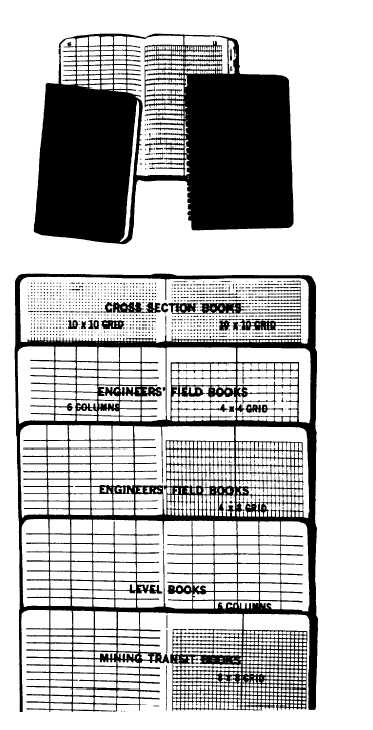or traverse numbers, may also be painted on. For
a neater job, stencils are sometimes used.
FLAGGING
Colored cloth bunting or plastic tape is often
used to make stakes conspicuous so they will be
easier to find or to warn Equipment Operators
away. Flagging may also be used for identification
purposes. For example, traverse stakes may be
marked with one color, grade stakes with another.
Red, yellow, orange, and white are the most
popular colors of flagging.
NOTE-KEEPING MATERIALS
Field notes are usually kept in a bound,
standard field notebook. Sometimes loose-leaf
notebooks are used but are not generally recom-
mended because of the chance of losing some
pages. Notebooks are classified as ENGINEER’S
or TRANSIT FIELD BOOKS, LEVEL BOOKS,
CROSS SECTION BOOKS, and so forth,
depending on their use.
In a transit book, the left-hand side of the page
is used for recording measurement data, and the
right-hand side of the page, for remarks, sketches,
and other supplementary information. The other
field books generally follow the same pattern of
usage. Different types of field books and inside
pages are shown in figure 11-58. Note how each
type is lined or gridded. Actually, a transit or a
level book may be used for recording any type
of survey. You may add or modify the column
headings to suit the required data you desire to
record.
PERSONAL PROTECTIVE AND
SAFETY EQUIPMENT
In addition to the necessary field supplies and
equipment, a field party must carry all necessary
items of personal protective equipment, such as
containers for drinking water, first-aid kits,
gloves, and foul weather gear, as needed. A field
survey party is usually working a considerable
distance away from the main operational base.
If, for example, you happen to be chaining
through a marsh filled with icy water, you would
not have a chance to return to the base to get your
rubber boots.
You are required to wear a hard hat whenever
you work in a construction area where the
Figure 11-58.-Diffferent types of field books.
assigned personnel are regularly required to wear
hard hats. Do NOT get caught-flat-footed in any
situation. To avoid this, you should study the
situation in advance—considering both the
physical and environmental conditions.
11-49

